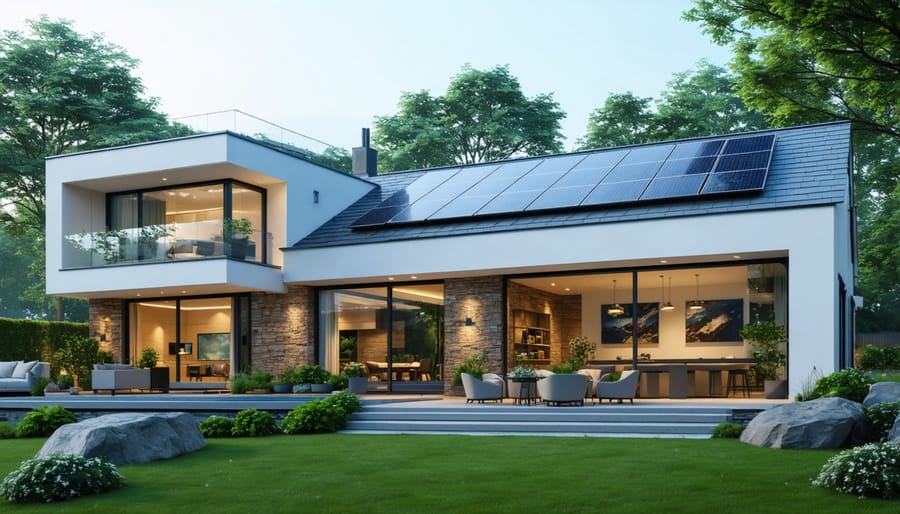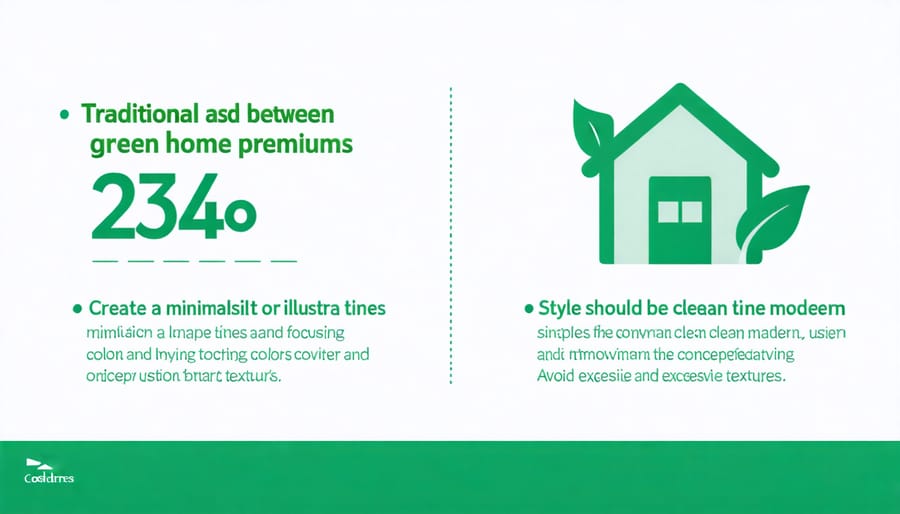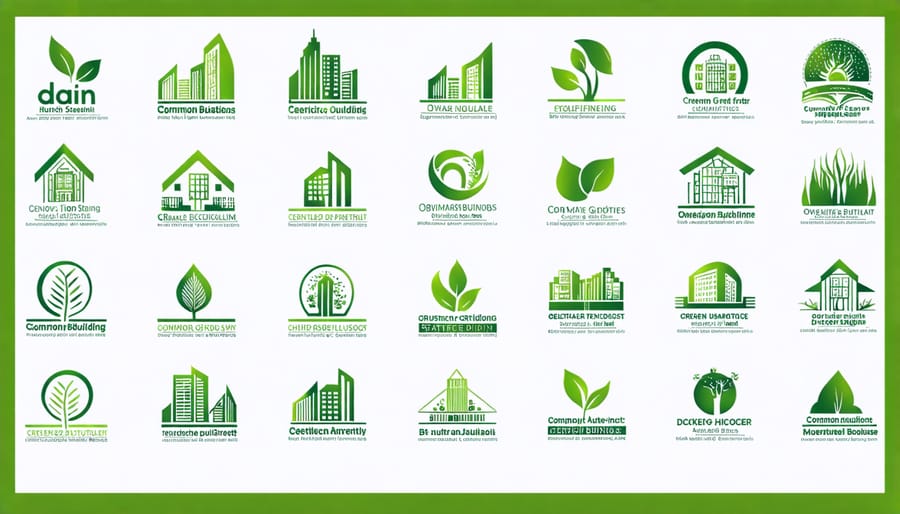Green home insurance transforms traditional property coverage into a powerful tool for environmental stewardship while protecting your financial future. As extreme weather events intensify, forward-thinking homeowners are discovering that climate resilience insurance offers both ecological and economic advantages. This innovative coverage extends beyond standard policies by supporting sustainable building practices, funding green repairs after damage, and rewarding energy-efficient home improvements with premium discounts.
While traditional policies simply restore properties to their original state, green insurance enables homeowners to upgrade to sustainable materials and energy-efficient systems during repairs. This dual benefit of environmental protection and long-term cost savings has sparked a revolution in the insurance industry, with major providers now offering specialized green endorsements and sustainability-focused coverage options.
For environmentally conscious homeowners, this specialized coverage represents more than just financial protection—it’s an investment in both property value and planetary health. Whether you’re retrofitting an existing home or building new with sustainable materials, green insurance provides the comprehensive coverage needed to protect and enhance your eco-friendly investment.
What Makes Home Insurance ‘Green’?

Eco-Friendly Coverage Options
Today’s eco-friendly insurance options extend well beyond basic coverage, offering specialized protection for sustainable home features. Most carriers now provide coverage for solar panels, geothermal systems, and energy-efficient appliances at full replacement value. Green building materials coverage ensures that damaged sustainable materials can be replaced with equally environmentally friendly alternatives, even if they cost more than standard materials.
Many policies also include green upgrade coverage, which allows homeowners to rebuild using sustainable materials and systems after a covered loss, even if the original features weren’t green. LEED certification coverage helps protect investments in achieving and maintaining green building certifications. For homes with living roofs or walls, specialized vegetation coverage ensures these unique features are protected against damage.
Additionally, some insurers offer coverage for alternative energy systems, including wind turbines and battery storage systems. Water conservation system protection covers rainwater harvesting equipment and greywater recycling systems. Smart home technology that helps reduce energy consumption or prevent water damage is often eligible for both coverage and premium discounts, making it easier for homeowners to maintain their eco-friendly investments while managing insurance costs.
Green Building Materials Protection
Green home insurance policies often include specialized coverage for sustainable building materials and eco-friendly components that traditional policies might not adequately protect. When renovating with sustainable materials, it’s crucial to ensure your insurance policy acknowledges their higher replacement costs and unique characteristics.
Coverage typically extends to materials like bamboo flooring, recycled metal roofing, solar panels, and energy-efficient windows. Many insurers now recognize green building certifications such as LEED, ENERGY STAR, and Green Globes, offering enhanced protection for homes meeting these standards.
What sets this coverage apart is its consideration of the premium nature of eco-friendly materials. For instance, if your recycled-content countertops or low-VOC materials are damaged, the policy ensures replacement with similar sustainable options rather than conventional alternatives. Some policies even include coverage for recertification costs if repairs affect your home’s green building status.
To maximize protection, document all sustainable materials and maintain current certification records. This documentation helps ensure smooth claims processing and appropriate compensation for these premium, environmentally conscious investments.
Financial Benefits of Green Home Insurance
Premium Discounts for Eco-Friendly Features
Insurance companies increasingly offer substantial discounts for homes with eco-friendly features, recognizing their lower environmental impact and reduced risk profile. These premium reductions can range from 5% to 25%, depending on the specific features and insurance provider.
The most significant discounts typically apply to homes with certified green building standards, such as LEED or ENERGY STAR certification. Homeowners can qualify for these discounts by implementing various environmentally conscious features:
– Solar panels and renewable energy systems (10-15% discount)
– Energy-efficient HVAC systems and smart thermostats (5-10% discount)
– Green roofing materials and cool roofs (up to 15% discount)
– Water conservation systems and smart irrigation (5-8% discount)
– Energy-efficient windows and doors (5-10% discount)
– Sustainable building materials (variable discounts)
To qualify for these discounts, homeowners typically need to provide documentation of their green features, including certification papers, installation receipts, or professional assessment reports. Some insurers may require an on-site inspection to verify the eco-friendly improvements.
Many insurance providers also offer additional incentives for upgrading to green materials when replacing damaged components during a claim. This “green upgrade” coverage ensures that repairs maintain or enhance the home’s environmental efficiency, often at little to no additional cost to the policyholder.
Remember to review different insurance providers’ specific criteria and discount structures, as offerings can vary significantly between companies.
Long-term Savings Analysis
When analyzing the long-term financial impact of green home insurance, homeowners often discover significant savings that extend well beyond reduced premiums. A comprehensive cost-benefit analysis typically reveals that while initial premiums might be 5-10% higher than traditional policies, the cumulative benefits substantially outweigh these costs over time.
For instance, a green home insurance policy that costs an additional $200 annually might save homeowners an average of $800-1,200 per year through various incentives, improved coverage options, and reduced utility costs. To effectively protect your eco-friendly investment, consider the following financial advantages over a 10-year period:
Energy-efficient upgrades covered by green insurance policies typically result in 20-30% lower utility bills. Additionally, these policies often include coverage for sustainable rebuilding materials, which can increase property value by 3-5% annually. When factoring in tax incentives and rebates available to eco-friendly homeowners, the total savings can amount to $15,000-$25,000 over a decade.
Most notably, homes with green insurance policies tend to maintain higher resale values, with market data showing a 7-9% premium over comparable traditional properties. This appreciation, combined with reduced maintenance costs and lower insurance claims rates, creates a compelling financial case for long-term investment in green home insurance strategies.

Qualifying for Green Coverage
Essential Home Features
Insurance providers typically look for specific eco-friendly features when determining eligibility for green home insurance discounts. Energy-efficient HVAC systems top the list, as they significantly reduce energy consumption and carbon emissions. Solar panels and other renewable energy installations are major qualifying features, often earning substantial premium reductions.
Smart home technology, including programmable thermostats and energy monitoring systems, demonstrates commitment to efficient resource management. High-performance windows and doors with proper weatherization contribute to better insulation, while sustainable building materials and green roofing systems show long-term environmental consideration.
Water conservation features like low-flow fixtures and rainwater harvesting systems are increasingly valued by insurers. Energy Star certified appliances and LED lighting throughout the home indicate reduced energy consumption. Enhanced insulation, including walls, attics, and crawl spaces, is crucial for maintaining optimal energy efficiency.
Several certification programs can validate your home’s green status, such as LEED certification or ENERGY STAR Home certification. These credentials often translate to better insurance terms. Consider implementing greywater systems and sustainable landscaping, as these features not only qualify for insurance benefits but also reduce your home’s environmental impact while lowering utility costs.

Certification Requirements
To qualify for green home insurance, your property typically needs to meet specific certification requirements established by recognized green building organizations. The most widely accepted certification is LEED (Leadership in Energy and Environmental Design), which evaluates factors like energy efficiency, sustainable materials, and water conservation. Properties can achieve different LEED levels – Certified, Silver, Gold, or Platinum – each offering potentially greater insurance benefits.
Another respected certification is ENERGY STAR, administered by the U.S. Environmental Protection Agency. Homes with this certification must meet strict energy performance standards, typically performing 20-30% better than standard homes. Many insurance providers also recognize certifications from the National Green Building Standard (NGBS) and regional green building programs.
Beyond these primary certifications, some insurers may require specific features like solar panels, green roofing systems, or energy-efficient HVAC systems to be professionally certified. Documentation of these installations and their compliance with local building codes is essential. Some providers might also accept alternative certifications like Passive House (PHIUS) or Living Building Challenge, particularly for high-end eco-friendly properties.
Remember to maintain current certifications, as letting them lapse could affect your insurance coverage or premium rates.
Making the Switch to Green Insurance
Policy Comparison Strategies
When comparing green home insurance policies, start by examining the specific eco-friendly features covered and their corresponding premium discounts. Create a detailed spreadsheet comparing different providers’ offerings, focusing on factors like renewable energy system coverage, sustainable building material protection, and green renovation reimbursement options.
Pay special attention to policy riders specifically designed for environmentally friendly home features. When choosing the right coverage, evaluate both the premium costs and the potential long-term savings through green incentives and discounts.
Consider these key comparison points:
– Coverage limits for green building materials
– Renewable energy system protection
– Energy-efficient upgrade allowances
– Green certification recognition
– Debris recycling provisions
– Sustainable reconstruction options
Request detailed quotes from multiple insurers and carefully review their green endorsements. Look for policies that offer flexibility in choosing sustainable materials during repairs or replacements. Some providers offer additional benefits like energy audit coverage or preferential rates for LEED-certified homes.
Remember to verify the insurer’s experience with green properties and their track record in handling eco-friendly claims. This ensures you’re partnering with a provider who truly understands sustainable building practices and green technology.
Implementation Timeline
Transitioning to green home insurance coverage typically follows a structured timeline that can be completed within 2-4 months. Begin by conducting a home energy audit and sustainability assessment during the first month, which helps identify areas for eco-friendly improvements and establishes a baseline for insurance negotiations.
In weeks 4-6, schedule consultations with insurance providers who specialize in green coverage. Use this time to compare policies, review coverage options, and understand specific requirements for qualification. Request quotes from multiple carriers to ensure competitive pricing.
Weeks 7-8 should focus on implementing necessary sustainable upgrades or certifications required by your chosen insurer. This might include installing energy-efficient appliances, upgrading insulation, or obtaining green building certifications.
During weeks 9-12, complete the application process and submit all required documentation, including proof of green improvements and certification credentials. Allow time for underwriting and policy review. Use this period to address any additional requirements or requests from the insurance provider.
The final phase involves policy activation and documentation review, typically taking 1-2 weeks. Remember to schedule regular reviews of your coverage, usually annually, to ensure you’re maximizing available green insurance benefits and keeping pace with new sustainable technologies and policy options.
As we’ve explored throughout this guide, green home insurance represents a significant opportunity for both environmental stewardship and financial savings. By implementing eco-friendly features and pursuing green certifications, homeowners can access premium discounts while contributing to a more sustainable future. The insurance industry’s growing recognition of sustainable building practices has created a win-win situation where environmental responsibility meets financial prudence.
To get started with green home insurance, begin by conducting an energy audit of your property and identifying potential improvements. Focus on high-impact modifications like energy-efficient appliances, solar panels, and sustainable building materials. Remember to document all green improvements and certifications, as these will be crucial when negotiating with insurance providers.
Take time to research and compare different insurance companies’ green coverage options, as policies and discounts can vary significantly. Don’t hesitate to ask questions about specific green endorsements and rebuild coverage that ensures eco-friendly materials and methods will be used in case of damage.
Most importantly, view green home insurance as part of a broader strategy for sustainable living and long-term cost savings. The initial investments in green improvements may seem substantial, but the combination of reduced utility bills, insurance savings, and potential tax incentives often results in significant returns over time. By embracing these practices today, you’re not just protecting your home – you’re investing in a more sustainable and financially secure future.